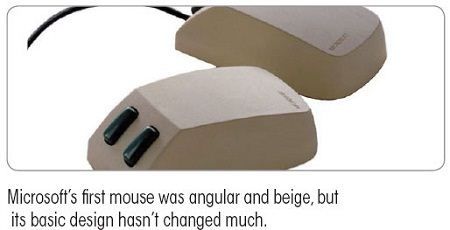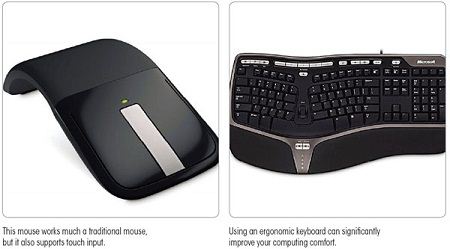List some of the important features of Mice & Keyboards
The mouse and keyboard are your PC’s eyes and ears; without them you could not execute commands or input text. In this article we’ll highlight some of their important features.
We’ll be covering the following topics in this tutorial:
All About Mice
A
mouse is an electro-mechanical device which is used to manipulate
objects on the screen. It is also known as a pointer. Even though the
mouse is a peripheral device, still it is one of the important parts of
the computer
hardware. The mouse detects 2-d motion relative to a surface. This
motion is translated into the motion of a pointer on a display, which
allows a smooth control of the graphical user interface.
A mouse is supported by only those devices which have GUI i.e. graphical user interface. Originally it was connected to computer
but now days it is used as wireless. Originally, it is used as a ball
rolling on the surface to detect motion, but these days they have
optical sensors which have no moving parts.
Laptops touch screen
phones etc. don’t require a mouse but they all use the same concept to
communicate with the devices. However, many of these devices can use
mouse as an optional device.
The mouse was originally referred to as
an X-Y position indicator for a display system. It was invented by
Douglas Engelbart in 1964. Prior to this invention, computer users had
to enter text-based commands to do tasks, like opening files/folders,
moving between them.
Operation: The mouse turns movements of the
hand backward and forward, left and right into equivalent electric
signals that are used to move the pointer.

Tracking Technology
The
most basic mice for sale today let users manipulate the position of the
pointer onscreen by mechanical means. A rubberized sphere inside the
mouse body contacts a pair of rollers that drive gears, moving the mouse
across a surface rotates the gears and the mouse’s driver translates
the movement to appear onscreen. These mice are very inexpensive, but
they tend to get clogged and require occasional cleaning. In 1999,
Microsoft launched an optical mouse that used an LED and photo diodes to
translate the mouse movements into the cursor position. Later optical
mice used tiny low-resolution image sensors to track movement, enabling
these modern optical mice to work on most surfaces. Laser mice use
infrared laser diodes to provide very precise movement data, making it
ideal for graphics professionals, engineers, and gamers.
Glass
has been one of the few surfaces on which modern mice still have
trouble tracking, but with the introduction of dual-laser and glass
laser mice, reflective and transparent surfaces are no longer a problem.

All About Keyboards
What is keyboard: A Computer keyboard is an input device used to input text and characters. The keyboard is extremely important accessory for a computer. The keyboard gives information about all keys which has used data typing in the computer. It is also known as an external peripheral device in a desktop system or is “virtual keyboard” in mobile or tablet. It connects to the computer system through a cable or wireless connection.
Layout Types
The
standard keyboard offers roughly 100 characters for letters,
punctuation, numbers, and function keys. Laptops tend to have
scaled-down keyboards, combining characters and actions that users can
access as if using standalone function keys. Smartphones and handheld
devices combine even more functions and use very small keys, suitable
for thumbing.
Most
keyboards feature the QWERTY layout, which refers to the first six
letters of the top row on the left side of the keyboard. This layout
traces its roots back to the 1870s, when E. Remington And Sons,
manufacturers of firearms and typewriters, sought to avoid placing
letters often typed together near one another, which significantly
reduced the frequency of jams on Remington’s mechanical typewriters.
Switch Types
There
are several different mechanisms used to register keystrokes. Common
switch types include full-travel membrane and dome-switch keyboards that
consist
of
plastic keys over a layer of rubber domes. Some keyboards add springs
to the rubber domes for more rapid feedback. These keyboards are known
for being relatively quiet and having a smooth response. Mechanical
switch and buckling spring-style keyboards have a rapid response and
tend to generate an audible “clack” when keys are pressed. These
keyboards have a very different feel to them, compared to rubber
dome-style keyboards. To determine which type you prefer, go to a local
retailer and try out a few.
A Word About Wireless
Both keyboards and mice come in wired and wireless models. If cutting cord clutter matters to you, consider that wireless mice and keyboards require batteries to operate. They also require either a wireless dongle or a receiver at the end of a USB cord. The latter does add to your wiring, but at least these units can be tucked out of sight.
Input Essentials
You have a host of options when shopping for new input devices. Considering them carefully is the key to ending up with something that can make using your computer comfortable, satisfying, and even fun.
Ports and Interfaces
• Wireless keyboard are communicating with the computer via Bluetooth.
• Wired keyboard are communicating with the computer via a USB, PS/2, or Serial connection.
All type of keyboard are require device driver in order to use.
Types of keyboard
Basically, there are four types of keyboards which is the use of high scale
QWERTY keyboard: It is very popular. Its name has appeared on the top row first six letters of the keyboard. The arrangement of alphabetic keys is known as Qwerty Keyboard.
AZERTY keyboard: Azerty keyboard is a French version. The keyboard is slightly different from QWERTY keyboard.
DVORAK keyboard: Dvorak is especially designed to be easier to use and learn. We use less finger movement while typing. It has faster typing speed as compared to QWERTY and Azerty.
Multimedia keyboard: It contains additional keys and buttons for media option such as volume, brightness and video control, audio visual media and alarms. These keyboards are designed for Internet Browser. The special keys included in this keyboard are the Home key, Back and Forward key, E-mail launch key and browser launch key.
Wireless keyboard: It is operates without wire connection. It is also known as cordless keyboards. These keyboards require batteries.
Membrane keyboard: Membrane is used very rarely. This keyboard is non-moving pressure sensitive keys.
Multi functional Keyboards: These are customized keypads, fully programmable function, and soft macro keys. Also have facility for smart card reader, trackballs, etc. In additional, Multi functional keyboards have options for users to share access to PC and other sources. This kind of keyboard is generally used by financial traders, control room operator, emergency services, security and air traffic management.
Laptop keyboard: Laptop keyboard differs from desktop keyboard. It is small in size and weight as compared to desktop keyboard. Bit functions are similar.
Smart phones and Tablet keyboard: These are not physical keyboard. It is optional to work with original keyboard. There is a visual touch screen keyboard on the display, we type by touch screen on the display with fingers.
Shortcut keys of Keyword
It gives the way to make work easier and quicker in executing commands in shortcut keys. The shortcut keys are – ALT key, Ctrl key, Tab, Shift key. We combine these keys with characters. For instance, there are some common features of shortcut keys.:
Ctrl + S (save)
Ctrl + O (open)
Ctrl + A (select all)
Ctrl + N (New)
Ctrl + Tab
We can switch between open programs while making a project or data. The most important shortcut key is Ctrl + V (Paste) and Ctrl + C (Copy) to cut, copy and paste some details which is similar in other data or other projects. It also saves time.
Comments